Pakistan Floods 2025: Causes, Consequences, and the Way Forward
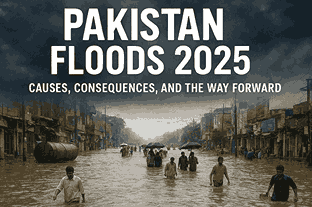
Introduction
In August 2025, Pakistan faced another devastating round of floods. First, a rare cloudburst in Buner unleashed over 150 mm of rain in an hour, triggering flash floods and landslides across Khyber Pakhtunkhwa’s mountainous terrain (Reuters, Wikipedia, People.com) 1. Soon after, Lahore and Sialkot endured record-breaking rain that paralyzed cities, submerged neighborhoods, and collapsed infrastructure (AP News, Aaj English TV, Dawn, The Express Tribune, Daily Pakistan, English News) 2.
These were not isolated disasters. Pakistan’s repeating flood crises reflect a complex mix of shifting climate patterns, poor infrastructure, environmental degradation, and governance gaps. To break this cycle, we must understand the root causes, assess the impact, and pave a way forward grounded in resilience and preparedness.
Causes of the 2025 Floods
1. Climate Change & Extreme Rainfall

Climate change intensified monsoon behavior, leading to abrupt, high-volume rainfall events. Pakistan witnessed an unnatural shift in monsoon trajectory, with heavy downpours striking areas like Buner—leading to the fatal cloudburst—and Punjab provinces where rivers and cities flooded in hours (Reuters, Wikipedia) 3.
2. Urban Infrastructure Failures

In Lahore, 136 mm of rain fell in eight hours in July, flooding low-lying neighbourhoods and even causing roof collapses (Aaj English TV) 4. In Sialkot, over 335 mm of rain overwhelmed clogged sewer systems, leading to submerged roads and markets (Dawn, Daily Pakistan, English News, HUM News) 5. These events highlight severely outdated drainage systems and unchecked urban sprawl without adequate flood planning.
3. Environmental Degradation

Deforestation in hilly regions, including KP, removes essential natural protection against rapid runoff and soil erosion. In Buner, loose soil and deforested slopes exacerbated flash floods and landslides following the cloudburst (Al Jazeera, Wikipedia) 6.
4. Transboundary Water Management
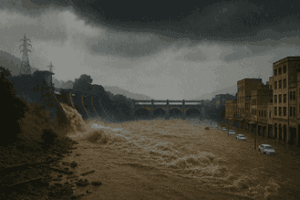
Authorities confirmed that Indian water releases from the Madhopur barrage and dam gates intensified river overflow in Punjab, including Lahore and Sialkot (Reuters) 7. Such sudden influxes stress limited warning systems and flood defenses, further exacerbating regional vulnerability.
5. Weak Governance & Disaster Response

Local administrations could not respond effectively to rapid flood progression. Evacuations came late; relief resources remained scarce; affected communities reported being abandoned during the crisis (The Guardian, AP News, People.com) 8. These failures to act prevent resilient outcomes even when nature delivers predictable risks.
Consequences of the 2025 Floods
1. Humanitarian Crisis & Loss of Life
Since June, over 800 people lost their lives across Pakistan due to monsoon-related flooding (AP News, Wikipedia, Reuters) 9. Buner alone recorded at least 207 deaths and many missing due to the cloudburst (People.com, Wikipedia) 10. In Punjab, more than 300,000 were displaced, with entire villages submerged and threats of waterborne diseases looming (The Guardian, AP News) 11.
2. Economic Devastation
Floodwaters destroyed crops and affected supply chains. The inundation in central Punjab, including major urban centers, disrupted transport and economic activity (Reuters, Pakistan Today) 12. These disasters deepen financial hardship for communities already struggling with poverty.
3. Health & Sanitation Emergencies
Flooding contaminated water supplies. Health officials warned of cholera, hepatitis, snake bites, malaria, and skin infections spreading rapidly. Many displaced people lacked medicine, clean water, and sanitation services (The Guardian, AP News) 13.
4. Infrastructure Breakdown & Disrupted Education
Ravi River overflow threatened housing societies near Lahore’s Thokar Niaz Baig, forcing evacuations (Daily Pakistan, English News) 14. In Sialkot, schools closed following unprecedented rainfall, and bridges collapsed, cutting off access to critical regions (Daily Pakistan English News, HUM News) 15. Disruptions in transport and utilities further complicated relief efforts.
5. Long-Term Environmental Damage
Repeated flooding erodes fertile soil and damages land. Urban sewage mixing with floodwaters raises long-term ecological and health threats. Without environmental recovery initiatives, future floods will yield even greater losses.
The Way Forward
1. Reinforce Infrastructure & Urban Resilience
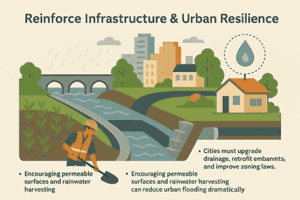
Cities must upgrade drainage, retrofit embankments, and improve zoning laws. Encouraging permeable surfaces and rainwater harvesting can reduce urban flooding dramatically.
2. Environmental Restoration
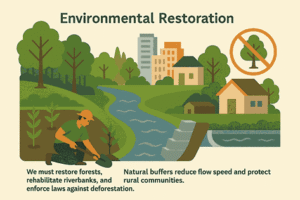
We must restore forests, rehabilitate riverbanks, and enforce laws against deforestation. Natural buffers reduce flow speed and protect rural communities.
3. Climate-Adaptive Policies
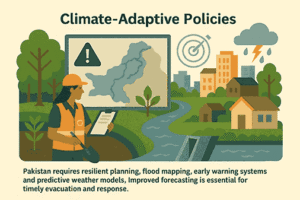
Pakistan requires resilient planning, flood mapping, early warning systems, and predictive weather models. Improved forecasting is essential for timely evacuation and response.
4. Transboundary Water Agreements
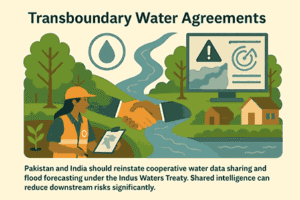
Pakistan and India should reinstate cooperative water data sharing and flood forecasting under the Indus Waters Treaty. Shared intelligence can reduce downstream risks significantly.
5. Strengthen Governance & Community Preparedness
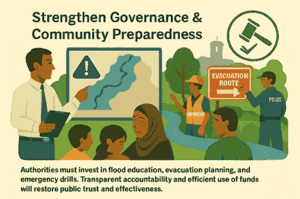
Authorities must invest in flood education, evacuation planning, and emergency drills. Transparent accountability and efficient use of funds will restore public trust and effectiveness.
6. Prioritize Relief, Rehabilitation & Mental Health
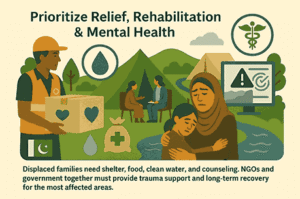
Displaced families need shelter, food, clean water, and counseling. NGOs and government together must provide trauma support and long-term recovery for the most affected areas.
Conclusion
The 2025 floods in Buner, Lahore, and Sialkot have once again exposed Pakistan’s vulnerability to climate shocks. These disasters are not just nature’s fury—they are signs of unprepared systems and weakened resilience. Yet, Pakistan has the chance to emerge stronger. By combining environmental restoration, infrastructure reform, community education, and regional cooperation, we can transform vulnerability into preparedness. The future depends on whether we treat these floods as crises—or catalysts for change.
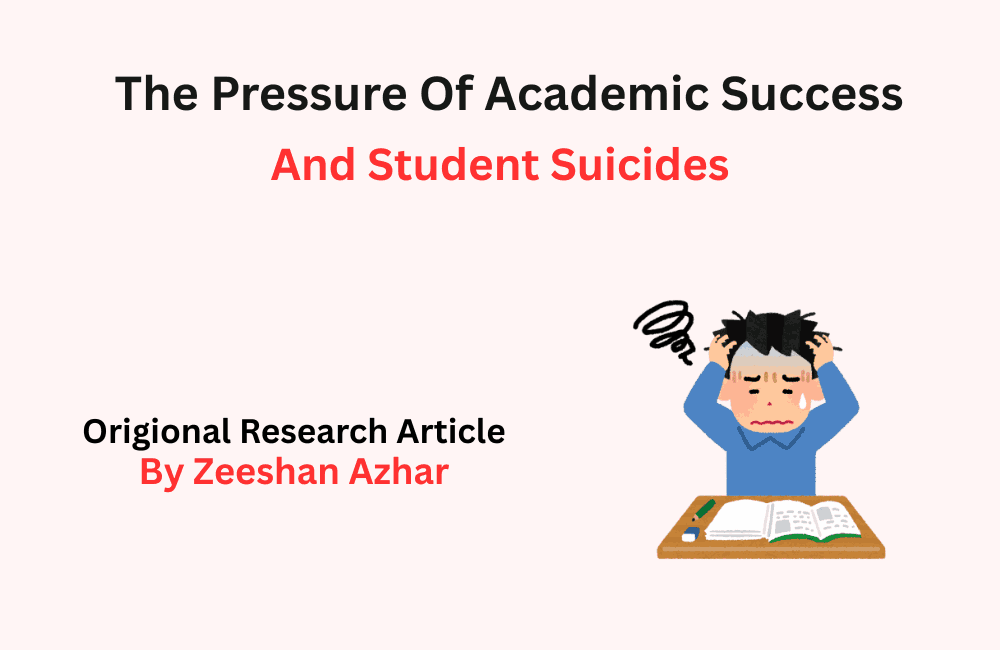
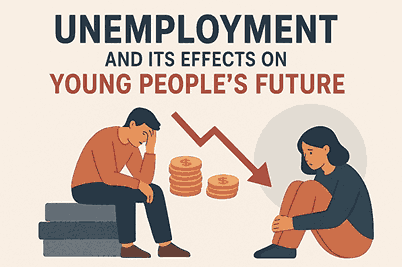



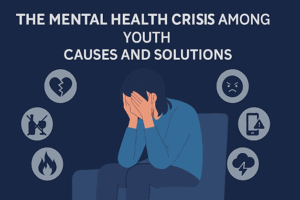






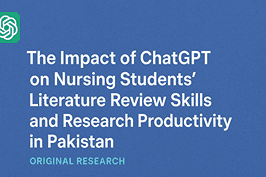
Post Comment